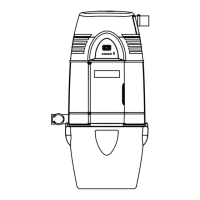Use the following procedures for installation in existing
construction. Wall inlets in existing construction may be
accessed from below (basement or crawl space) or from
above (attic). Instructions apply to either method.
Starting from farthest wall inlet location, install each inlet as
described below. Working back toward power unit, connect
each inlet line and branch line into main trunk line. See pages
2 and 3. Complete low-voltage wiring as main trunk line is
continued back to power unit. Mount power unit and complete
wiring. See pages 18 and 19.
LOCATING ACCESS KEYS
IN EXISTING CONSTRUCTION
Unless your home is a ranch-style house where a single trunk
line can run directly through the attic or basement, you should
first investigate your house to find the key to running your
tubing from level to level. Look for an accessible area free
from obstructions that will accommodate the 2" (51 mm) tubing.
If you understand how your existing home is constructed, it
can be relatively easy to find access routes to run the tubing.
Refer again to the illustrations on pages 2 and 3 as you
consider your home construction.
Some of the keys you might find in your home are illustrated
here.
Stacked Closets or Laundry Chute
Many homes will have an upstairs closet located directly
above a downstairs closet. It is easy to run the tubing from
one floor level to another inside these stacked closets. In
these installations the tubing is often left exposed inside the
closets. Refer to Figure 19. A laundry chute could also provide
access from basement to upper floors. You may also want to
consider running exposed tubing through cabinets or cupboards.
AVOIDING IN-WALL OBSTACLES
The tubing which connects the inlet into the trunk line is
threaded through interior partition walls. After you’ve chosen
an inlet location, make sure the wall doesn’t contain some
hidden obstacle which will prevent you from running tubing to
the inlet.
Exterior Walls. The insulation in these walls will prevent you
from running tubing through them.
Electrical Wiring. Wiring may not obstruct your tubing, but you
should always make sure that tubing does not damage the
wiring. Electrical outlets and wall switches are signs of wiring.
Ductwork. Avoid choosing a section of wall that contains
ducting. If you see signs of ductwork—such as floor or ceiling
registers—move your inlet location to another section of the wall.
Plumbing. Plumbing may or may not prevent you from
running tubing through a wall. If you must choose a plumbing
wall for an inlet location, be extremely careful when making a
cutout in the wall.
Wall Studs. Make sure your location is between wall studs.
Locate studs by tapping walls, looking for electrical outlet
(usually fastened to studs), or noticing finishing nails in the
floor molding.
INLET TUBING INSTALLATION
When your planning is complete, you will have to determine
where all the inlets and the power unit will be located. You
have mapped out the location of your trunk line and found the
access you need to run vertical tubing from one level of your
house to another level. You should have acquainted yourself
with the methods of joining plastic tubing and acquired the
tools you will need to install your Broan or NuTone Central
Vacuum System. Now, you can begin installation.
The first step is to install the inlet tubing which connects the
wall inlets to the branch lines. As explained before, the inlet
lines run inside interior walls. You will find access to these
walls through your attic or basement. Briefly, you want to find
the exact location in the wall, drill an access hole through the
wall plate or header, and insert the tubing into the wall cavity.
This part of your installation requires close observation and
careful measurements. Take your time and make sure you
accurately line up your access holes with the locations you’ve
chosen for your wall inlets.
Locating Attic Access Holes
Drill the access holes directly above the inlet location.
To accurately locate the access hole, you must find the space
between wall studs where the inlet is to be located. Observe
the area around the inlet location. Look for references you
might be able to find in the attic: electrical wiring, ductwork,
doorways, etc. Measure and note the distance from these
references to the inlet location.
page 7
INSTALLATION IN EXISTING CONSTRUCTION

